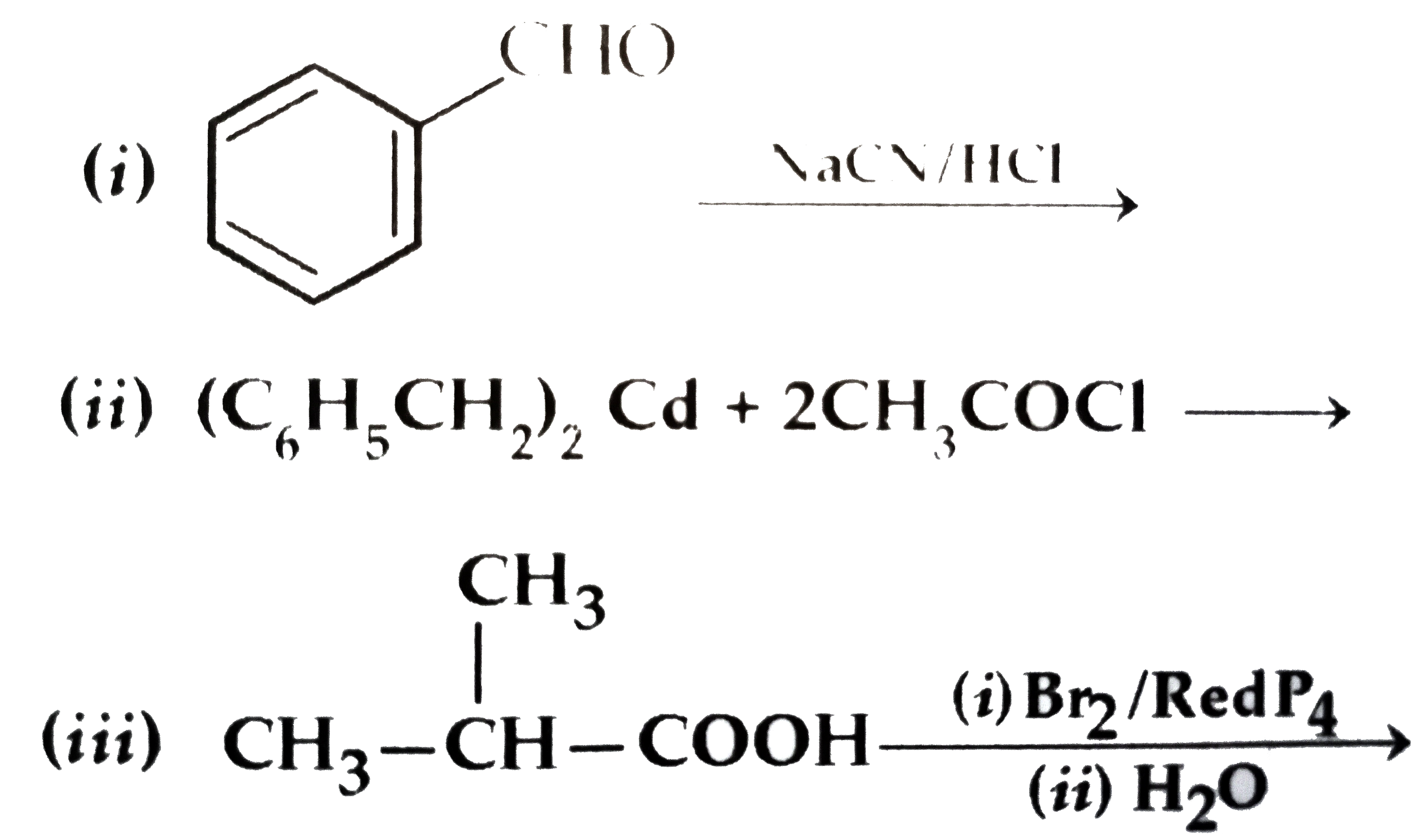Complete the following reactions:
CH3−CH3∣CH−COOH(i)Br2/Red P4−−−−−−−−−→(ii)H2O
To complete the given reaction step by step, we will follow the provided information and the chemical transformations involved.
Step 1: Identify the Reactant
The given reactant is CH3−CH(CH3)−COOH, which is 2-methylpropanoic acid.
Step 2: Understand the Reaction Conditions
The reaction conditions provided are:
1. Br2 in the presence of RedP4 (which indicates a bromination reaction).
2. Water (H2O) is also present, which suggests that we may have a hydrolysis or a substitution reaction following the bromination.
Step 3: Perform the Bromination Reaction
When 2-methylpropanoic acid reacts with bromine in the presence of red phosphorus, bromine will add to the carbon chain. The bromine will preferentially add to the carbon atom that is most substituted, which in this case is the second carbon (the one attached to the methyl group).
Thus, the bromination of 2-methylpropanoic acid will yield:
- Product after bromination: 2-bromo-2-methylpropanoic acid.
Step 4: Consider the Role of Water
The presence of water suggests that we may have a hydrolysis reaction occurring after bromination. However, in this case, since we are dealing with a carboxylic acid, the addition of water does not change the structure significantly after bromination.
Final Product
Therefore, the final product of the reaction is:
- Final Product: 2-bromo-2-methylpropanoic acid.
Summary of the Reaction
The complete reaction can be summarized as:
\( \text{2-methylpropanoic acid} \xrightarrow{\text{Br}_2/\text{Red P}_4} \text{2-bromo-2-methylpropanoic acid} \)
---
The given reactant is CH3−CH(CH3)−COOH, which is 2-methylpropanoic acid.
The reaction conditions provided are:
1. Br2 in the presence of RedP4 (which indicates a bromination reaction).
2. Water (H2O) is also present, which suggests that we may have a hydrolysis or a substitution reaction following the bromination.
When 2-methylpropanoic acid reacts with bromine in the presence of red phosphorus, bromine will add to the carbon chain. The bromine will preferentially add to the carbon atom that is most substituted, which in this case is the second carbon (the one attached to the methyl group).
- Product after bromination: 2-bromo-2-methylpropanoic acid.
The presence of water suggests that we may have a hydrolysis reaction occurring after bromination. However, in this case, since we are dealing with a carboxylic acid, the addition of water does not change the structure significantly after bromination.
Therefore, the final product of the reaction is:
- Final Product: 2-bromo-2-methylpropanoic acid.
The complete reaction can be summarized as:
\( \text{2-methylpropanoic acid} \xrightarrow{\text{Br}_2/\text{Red P}_4} \text{2-bromo-2-methylpropanoic acid} \)
Topper's Solved these Questions
Similar Questions
Knowledge Check
- Question 1 - Select One
The major product formed in the reaction is:
CH3−CH3∣C∣H−CH2BrCH3OӨ−−−−→CH3OHACH3−CH3∣C∣H−CH2OCH3BCH3−C∣OCH3H−CH2CH3CCH3−CH3∣C=CH2DCH3−CH3∣C∣OCH3−CH3 - Question 2 - Select One
In the following reaction :
H3C−CH3| C | CH3−CH=CH2H2O/H⊕−−−−−→A
The major product A is :ACH2| OH−CH3| C | CH3−CH2−CH3BH3C−CH3| C | CH3−CH| OH−CH3CH3C−CH3| C | CH3−CH2−CH2| OHDH3C−CH3| C | OH−C | CH3−CH3
Complete the following reactions:
(i)
(ii) (C6H5CH2)2Cd+2CH3COC<o
(iii) CH3−CH3∣CH−COOH(i)Br2/RedP4−−−−−−−−−→(ii)H2OView SolutionComplete the following reactions:
(i) CH3−CH3∣C∣Cl−CH2CH3alcKOH−−−−→ΔAO3−−−−−→Zn/H2O(B+C)
(ii) CH3ICH−CH3alcKCN−−−−→A(i)SnCl2/HCl−−−−−−−−−−−−→(ii)H2O.OH.H2O2B
(iii) HCNHCl/AlCl3−−−−−−→A(i)C6H6Δ−−−−−−−−−−→(ii)(H2O)/H−B
(iv) View Solution
View SolutionComplete the following reaction sequence
CH3−O∣∣C−CH3(i)CH3MgBr−−−−−−−−→(ii)H2O(A)Na metal −−−−−→Ether (B)CH3−Br−−−−−→(C)View Solution(a) Complete the following equations :
(i)
(ii) CH3COOHLiAIH4−−−−→
(iii) CH3−COOH3(a)Cl2/P−−−−−−→(b)H2O
(b) Distinguish between :

(ii) CH3−CHOandCH3−C∣∣O−CH3View SolutionComplete the following reaction sequence :
CH3−O∣∣C−CH3(i)CH3MgBr−−−−−−−−→(ii)H2O(A)Na metal−−−−→ether(B)CH3−Br−−−−−→(C)View SolutionComplete the following reactions:
(i) CH3−CH2−O−CH3| C | CH3−CH3−HIHeat−−→
View Solution

